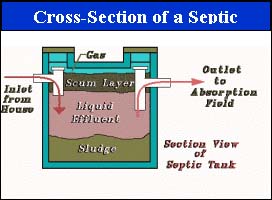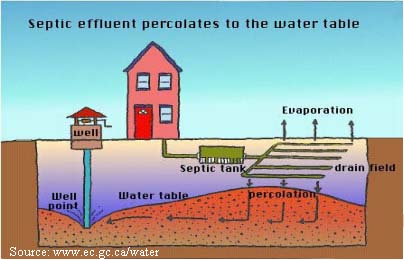Septic System Users
How Do Septic Systems Work?
 Septic tanks collect sink, bathtub, laundry, and toilet wastewater. As shown in the adjacent diagram, solid material (sludge) settles to the bottom of the tank, while oils and less dense materials float to the top (scum layer). While the effluent is detained in the tank, decomposing bacteria perform the important function of breaking down the organic material in the effluent, thereby reducing the total quantity of nutrients and pathogens in the wastewater, two elements that impact groundwater quality.
Septic tanks collect sink, bathtub, laundry, and toilet wastewater. As shown in the adjacent diagram, solid material (sludge) settles to the bottom of the tank, while oils and less dense materials float to the top (scum layer). While the effluent is detained in the tank, decomposing bacteria perform the important function of breaking down the organic material in the effluent, thereby reducing the total quantity of nutrients and pathogens in the wastewater, two elements that impact groundwater quality.
The liquid effluent in between the sludge and the scum layers flows from the tank into a septic field. The septic field consists of perforated drainage pipes surrounded by soil and vegetation, which filter the effluent. As effluent passes through the septic field, bacteria and other microorganisms in the soil further biodegrade the effluent’s organic content, to reduce it to a state that does not pose a contamination concern. The sludge and scum layers remain in the tank and must be removed professionally by a septic system pump-out contractor, every two to three years.
How Could a Septic System Cause Groundwater Contamination?
Groundwater contamination may occur when insufficiently treated septic effluent is released into the environment where it is then able to percolate down to the groundwater table. Excess nutrients such as nitrogen and phosphorus in addition to a variety of pathogenic bacteria will reduce groundwater quality and may impact our potable water resources.
Inadequate treatment of wastewater in a septic system may occur for one of several reasons:

- When septic tanks are not pumped regularly, sludge levels in the tank become so high that there is insufficient space in the tank for liquid effluent. As a result, overflows occur and the effluent is not detained in the tank for a long enough period for the biological decomposition to occur. The contaminated effluent is transferred directly to the septic field.
- Septic tanks or systems, which have not been regularly maintained, may suffer from cracks or leaks due to settling of soils or wear of system components. Leaks from the system release contaminated wastewater directly into the environment. Blockages in the system, which lead to overflows, may not be detected without regular, thorough inspections of the tank and drainage units.
- Septic system capacities must be observed to prevent overuse and overflow issues.
Look for the following warning signs, which indicate that your system may need servicing:
- Unpleasant odours
- Surfacing sewage
- Slow or backed-up drains
- Patches of vibrant vegetative growth over the drain field caused by excess organic material in effluent.
What Actions Can be Taken to Protect Our Groundwater?
Learn the location of your septic system and drain field. Keep a photo or map of its location showing its position relative to a fixed point. Provide appropriate indicators for access hatches. Tape this map or drawing to your electric panel door for your reference or future owners’ reference.
Have your tank inspected every year and pumped out every two to three years. Ensure that professionals verify the entire system field, distribution box and pump chambers during inspection. Keep a record of pumping inspections and other maintenance. Contact your local Environmental Health Officer for permits, or information on repairs, maintenance, installations, or drainage of the disposal area.
Protect access hatches from water infiltration by raising them above ground level. Also, minimize infiltration of water into your septic system by not watering vegetation on top of the drain field and by diverting roof, patio, hill side and driveway runoff away from the drain field.
Practice water conservation by using low flush toilets, water saving faucets and showerheads, and operating the dishwasher and laundry machine only on full loads. This will prolong the life of your system.
Never pour hazardous wastes into your sinks or toilets, including paints, kerosene, solvents, antifreeze, gas, oil, herbicides and pesticides, down drains or toilets, as they can leach from the septic system into groundwater and contaminate our potable water supply. Take leftover portions of these hazardous wastes to the Hazardous Waste Collection Site, located at the Chilliwack Bottle Depot, 45934 Trethewey Avenue.
Plant grass on your drain field rather than trees or shrubs as grass tends to have a superior filtering effect and reduces the potential of root damage to the field drain portion of the septic system.
Never put non-degradables down sinks or toilets. Non-degradables include: cigarette butts, filters, sanitary items, newspaper, disposable diapers, condoms, facial tissue, paper towels, hair, metal, tea leaves, coffee grounds, cat litter, fats & grease, etc. These items can plug your septic system and drain field.
For Further Information
Drinking Water in the City of Chilliwack
Engineering Department
City of Chilliwack
8550 Young Road
(604) 793-2907
Groundwater Protection
BC Ministry of Environment
604.582.5200
National Groundwater Association
1-800-551-7379
Recycling and Disposal of Hazardous Materials
BC Recycling Hotline
1-800-667-4321
Chilliwack Bottle Depot
Unit 2 45934 Trethewey Avenue
(604) 792-9572
Fraser Health Authority
45470 Menholm Road
Chilliwack BC
V2P 1M2
(604) 702-4900
